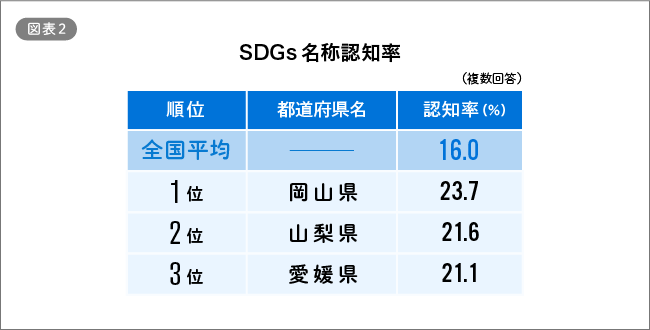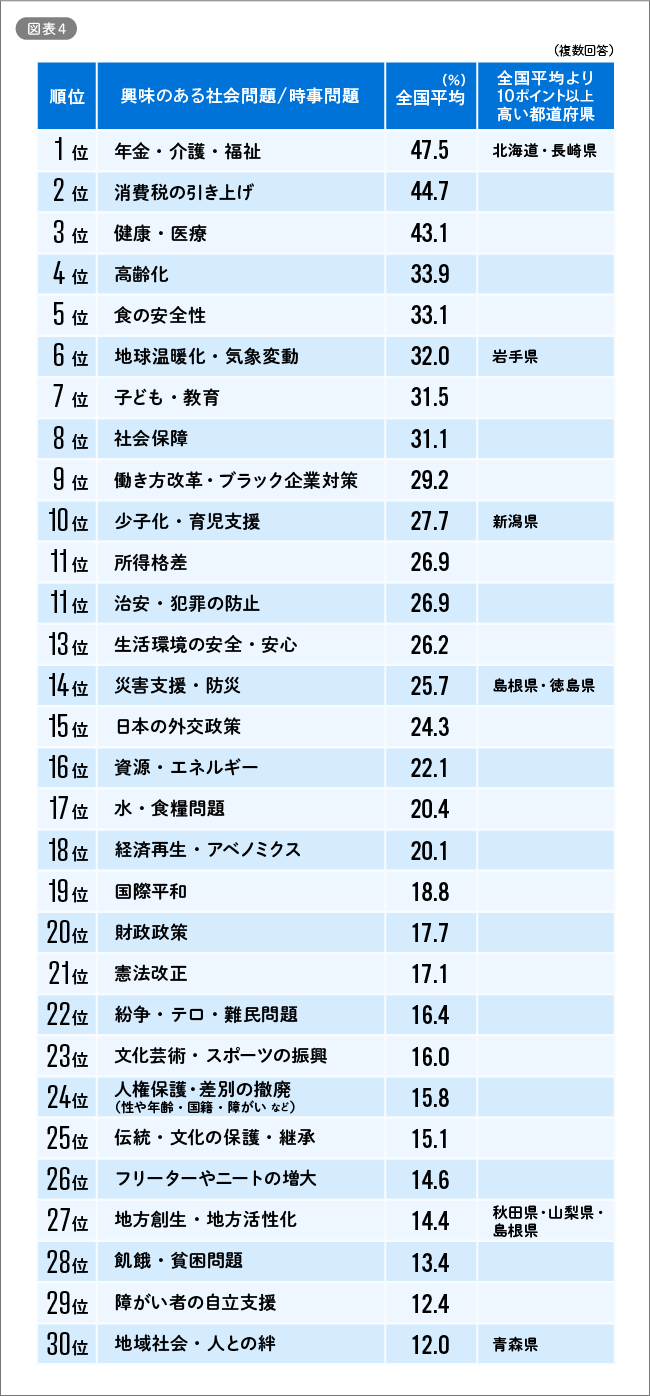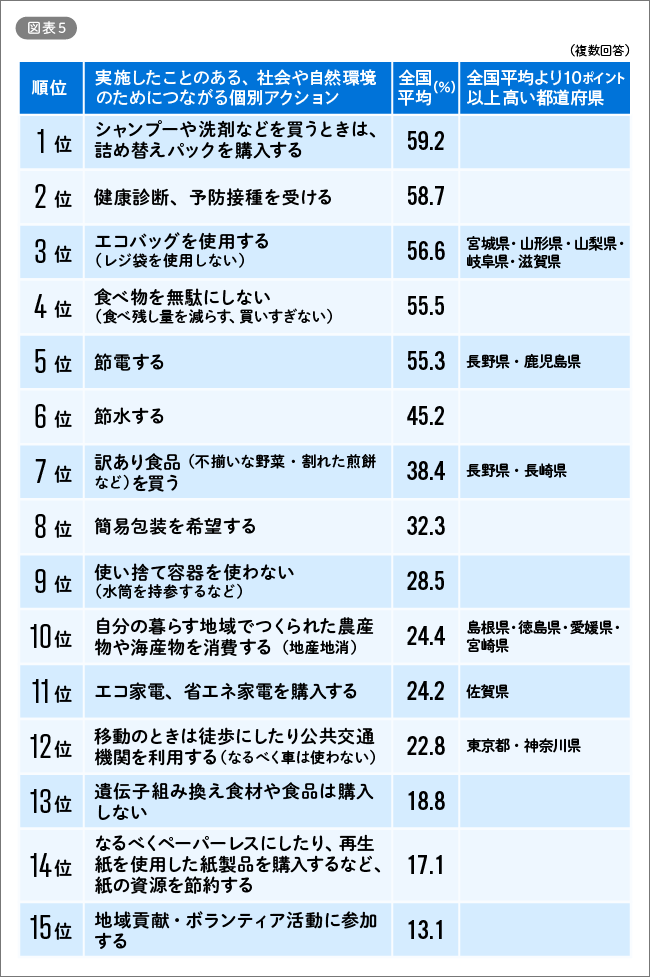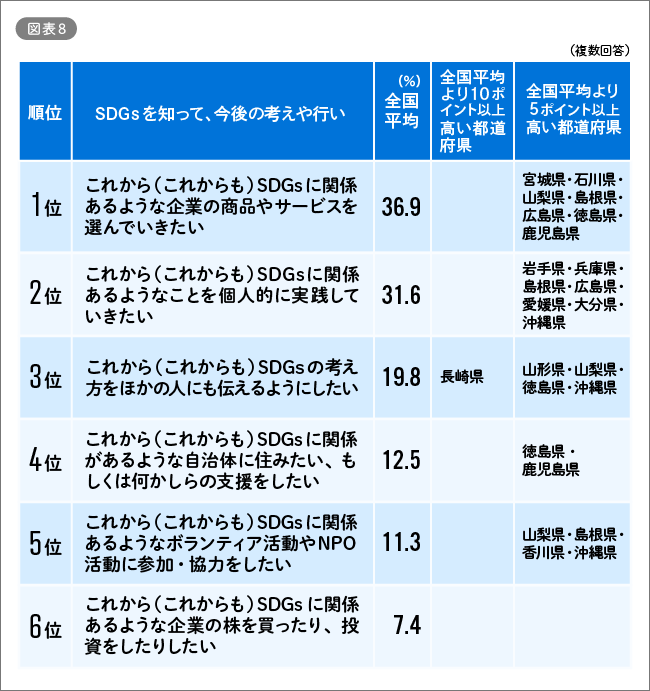Note: This website was automatically translated, so some terms or nuances may not be completely accurate.
Exploring SDGs Implementation Across Prefectures
Part 2 of this series continues from Part 1, focusing on the findings of the "Second Dentsu SDGs Consumer Survey" by prefecture and reporting on them.
Table of Contents
▼Prefectures with Highest SDGs Name Recognition Rates
▼Prefectures Showing National Trends and Distinctive Features Regarding SDGs
▼Summary: Further expanding SDGs awareness and promoting SDGs tailored to each prefecture's circumstances
Prefectures with Highest SDGs Name Recognition Rates
The national average name recognition rate for the SDGs in this survey was 16.0%. Examining this by prefecture reveals the distribution shown in the figure below.

Here are the top three prefectures with particularly high awareness rates in the 20% range.

Okayama Prefecture had the highest SDGs name recognition rate at 23.7%.
In Okayama Prefecture, many people were not only aware of the SDGs name but also knew their content. For six of the 17 goals (Figure 3), the awareness rate was more than 10 percentage points higher than the national average.

We explored why SDG awareness is high in Okayama Prefecture.
In 2005, the Okayama City area became the world's first region designated by the United Nations University as a regional hub for promoting "ESD" (Education for Sustainable Development).
In 2017, Okayama University received the SDGs Partnership Award at the inaugural Japan SDGs Awards. The university promotes initiatives incorporating the SDGs perspective into university management, fostering academic contributions through research activities and social contribution/exchange programs, cultivating global talent, and building more integrated partnerships between the region and the international community.
Okayama City and Maniwa City were selected as "SDGs Future Cities" in 2018. Okayama City is working on "Promoting Okayama: A City Where Everyone Can Live Healthy, Learn Together, and Thrive Throughout Life," while Maniwa City is pursuing "Achieving 100% Local Energy Self-Sufficiency: Realizing Maniwa as an SDGs Future City ~ Aiming to be a Model for Sustainable Development in Rural and Mountainous Areas (A City Where I Can Live Authentically) ~".
This recognition rate likely reflects the solid, steady groundwork laid ahead of others by Okayama Prefecture, with its cities and universities taking the lead.
Yamanashi Prefecture (21.6%) and Ehime Prefecture (21.1%) ranked second and third in SDGs name recognition rates.
Yamanashi Prefecture showed a significant difference in Chart 4 (explained later), where 30.9% of respondents selected "Regional Revitalization/Local Activation" as a "Social Issue/Current Event of Interest," 16.5 percentage points higher than the national average of 14.4%. Furthermore, Kitakami City is collaborating with local high schools, businesses, and the Small and Medium Enterprise Agency Kanto to advance SDGs-related initiatives focused on "Promoting Sustainable Community Development" that leverage food and agriculture.
Ehime Prefecture showed recognition rates for four of the 17 goals that were 5 percentage points or more above the national average. It also showed that 34.7% of respondents reported "practicing local production for local consumption" as an action they had taken (Figure 5), 10.3 percentage points higher than the national average of 24.4%.
Furthermore, Uchiko Town, whose SDGs initiatives were featured in the 2017 Environmental White Paper, is well-known among NGOs and others engaged in SDGs activities. This year, with the G20 Summit—where SDGs are a major theme—being held in Matsuyama City, Additionally, the "Regional Revitalization Youth Meeting," targeting those interested in regional revitalization, is scheduled to be held in Matsuyama City. This meeting will focus on themes such as work-style reform and entrepreneurship.
Both Yamanashi and Ehime Prefectures may be seeing SDGs take root as a result of successfully linking regional challenges like "regional revitalization" and "aging populations" with the 17 goals.
Prefectures Showing National Trends and Characteristics in SDGs
This survey included various questions beyond awareness to understand the current situation. Below are some results (national average) alongside prefectures showing notable characteristics.

This survey included "social/current issues of interest" as one of its items. Since some aspects of the 17 SDG goals can be difficult for Japanese people to visualize, replacing them with "specific social/current issues in Japan" helped clarify areas of concern.
Ranking first nationwide was "Pensions, Nursing Care, Welfare" (47.5%). Issues directly linked to personal future anxieties, such as second-ranked "Consumption Tax Hike" (44.7%) and third-ranked "Health and Medical Care" (43.1%), also ranked highly.

Even without knowing or consciously thinking about the SDGs, people may be engaging in SDG-related actions. The highest-ranked such action was "Using refill packs" (59.2%). Perhaps due to its economic aspect, this slightly surpassed "Health checkups, vaccinations" (58.7%), with nearly 60% responding they had "done this before." "Using eco-bags" (56.6%), which is easy and stylish, and "Not wasting food" (55.5%), likely due to growing awareness of food loss, also ranked highly. While both "Saving electricity" (55.3%) and "Saving water" (45.2%) involve conservation, their implementation rates differ by over 10 percentage points, suggesting that "ease of implementation" in daily life is key.

Nationwide, "information websites" (39.6%) and "newspapers" (35.8%) were the primary sources of SDGs information, both exceeding 30%. "Newspapers" included a significant proportion of "local papers." The emergence of "direct" sources like "workplace activities," "school lessons," "events," and "conversations with others" in third place also reflects a characteristic of how SDGs awareness is spreading.

Regardless of whether respondents knew the SDGs by name, the most commonly practiced goal was Goal 3: Good Health (35.5%). This was followed by Goal 6: Clean Water and Sanitation (21.0%), Goal 2: Zero Hunger (20.0%), and Goal 1: No Poverty (19.3%). However, there is a gap of over 10 percentage points between these and "Good Health," the goal most easily internalized as a personal concern.
While "Health" and "Water and Sanitation" are likely to rank highly as they are familiar, approachable issues in Japan, the next highest goals were "Zero Hunger" and "No Poverty." These two goals likely ranked high because they are global challenges addressed by many organizations and frequently covered in the media.
Two prefectures showed distinctive scores over 10 points higher than the national average for the goals they were actively pursuing: Hiroshima Prefecture (33.3%) for Goal 6 "Water and Sanitation" and Tokyo Metropolis (23.5%) for Goal 16 "Peace, Justice, and Strong Institutions" (12.2%).

Regarding future SDG involvement, the most common response was "I want to choose products and services from companies related to the SDGs" (36.9%), indicating high expectations for corporate initiatives.
Summary: Further expanding SDG awareness and promoting SDGs tailored to each prefecture's circumstances
"Opportunity Lies in the SDGs!" In Part 2, we examined various SDGs engagement levels across Japan. What did you think? We hope you sensed the potential surrounding the SDGs from multiple perspectives.
This analysis revealed significant regional variations in SDG awareness—ranging from single-digit percentages to over 20% across prefectures—along with distinct local differences in areas of interest, current initiatives, and information channels. It also confirmed consumer demand for SDG-related products and services, highlighting the business opportunities SDGs present for companies.
These are all fascinating findings. It seems that activities by local governments and universities, who know their regions well, are acting as engines, gradually raising awareness. And it may be corporate initiatives that can now really accelerate this momentum.
The survey also asked about potential "barriers" to engaging with the SDGs. At home, "not knowing what to do" ranked highest nationwide, while in companies and schools, "difficulty because others around me don't know" was the top barrier.
Differences existed across prefectures. To advance SDG achievement, it seems necessary to expand awareness while presenting concrete actions using approaches tailored to each prefecture. To explore these methods, we plan to proceed with analyzing data from each prefecture going forward.
【Dentsu Inc. Team SDGs】
An internal cross-departmental team dedicated to researching and developing solutions that drive innovation toward achieving the SDGs, and disseminating related information.

【Survey Overview】
● Survey Name: 2nd Survey on SDGs Awareness Among Consumers
● Target Area: Nationwide, Japan
● Target Population: Men and women aged 10 to 70
● Sample Size: 6,576 people
For analysis, data was weighted to reflect each prefecture's population ratio and Japan's overall age and gender composition.
●Survey Method: Internet survey
●Survey Period: February 7–18, 2019
●Survey Agency: Dentsu Macromill Insight, Inc.
The major difference from the first survey is the significant increase in sample size, enabling analysis by all 47 prefectures. Consequently, the sample allocation conditions differ from the previous survey. Therefore, the national average values (GT values) from the first and second surveys are cited as reference values in certain sections.
Was this article helpful?
Newsletter registration is here
We select and publish important news every day
For inquiries about this article
Author

Michiko Obata
Dentsu Inc.
PR Solutions Division, Business Development Department
Integrated Marketing Strategist, PR Planner
After working as a sales representative, strategic planner, wellness (health and beauty) specialist planner, and brand consultant, I joined the PR Solutions Division. Leveraging my experience managing diverse categories of companies, businesses, brands, and products, I currently work primarily as a PR planner. Member of Dentsu Inc. Team SDGs.


